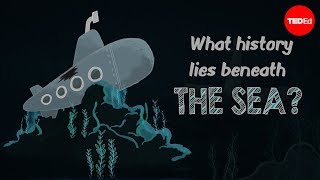(单词翻译:单击)
Sunken relics, ghostly shipwrecks, and lost cities.
沉没的文物,幽灵沉船和消失的城市。
These aren't just wonders found in fictional adventures.
这些不仅仅是在虚构冒险小说中的奇迹。
Beneath the ocean's surface, there are ruins where people once roamed and shipwrecks loaded with artifacts from another time.
在海洋表面下是人们曾经游荡过的废墟和装满另一个时代工艺品的沉船。
This is the domain of underwater archaeology,
这是水下考古现场,
where researchers discover and study human artifacts that slipped into the sea.
在那里研究者发现和研究沉入海底的人类工艺品。
They're not on a treasure hunt.
他们不是在寻找宝藏。
Underwater archaeology reveals important information about ancient climates and coastlines,
水下考古揭示了一些关于古代气候和海岸线的重要信息,
it tells us how humans sailed the seas, and what life was like millennia ago.
告诉我们人类如何航海以及1000年前人类的生活是什么样的。
So what exactly can we find?
我们到底可以发现什么?
At shallow depths mingled in with modern-day items, we've discovered all sorts of ancient artifacts.
在混合着一些现代物品的浅海中,我们发现了各种古代的工艺品。
This zone contains evidence of how our ancestors fished, how they repaired their ships, disposed of their trash,
这个区域含有我们的祖先如何钓鱼,如何修复船只,丢弃他们的废物的证据,
and even their convicted pirates, who were buried below the tide line.
甚至是被埋在潮汐线下被处死的海盗。
And it's not just our recent history.
不仅是我们近代的历史。
800,000-year old footprints were found along the shore in Norfolk, Britain.
在英国诺福克郡海岸还发现了80万年前的足迹。
In these shallow depths, the remains of sunken cities also loom up from the sea floor,
在这些浅海区,沉没城市的遗迹露出海床,
deposited there by earthquakes, tsunamis, and Earth's sinking plates.
它们沉积在那儿,是由于地震、海啸和地球板块下沉的作用。
Almost every sunken city can be found at these shallow depths
几乎所有的沉没城市都能在这些浅海区被找到,
because the sea level has changed little in the several thousand years that city-building civilizations have existed.
因为几千年来海平面的高度与当时那些城市文明被建造时相比只上升了一点点。
For instance, in shallow waters off the coast of Italy lies Baia, a Roman seaside town over 2,000 years old.
例如,位于意大利海岸外的浅水区有个巴亚,两千年前是个罗马的海边小镇。
There, it's possible to swim among the ruins of structures built by Rome's great families, senators, and emperors.
人们能在那建筑废墟间游泳,这些废墟是由罗马的尊贵家族、元老院和皇帝们所遗留的。

And then there are shipwrecks. As ships grow too old for use,
还有沉船。当船只太破旧无法再被使用,
they're usually abandoned near shore in out-of-the-way places like estuaries, rivers, and shallow bays.
往往被就近丢弃在岸边偏僻不碍事的地方,例如河口、小河和浅湾。
Archaeologists use these like a timeline to map a harbor's peaks and declines,
考古学家把这些当作时间轴来推算港口的繁荣和没落时期,
and to get clues about the historic art of shipbuiding.
并取得造船工艺历史的线索。
At Roskilde in Denmark, for example,
例如在丹麦的罗斯基勒,
five purposefully sunken vessels reveal how Vikings crafted their fearsome long ships 1,000 years ago.
有五艘被刻意沉没的船只,揭示出维京人如何在千年前建造这些可畏的船只。
When we descend a bit further,
若我们再往水下深入一点,
we reach the zone where the deepest human structures lie, like ancient harbor walls and quays.
就到了人类结构存在的最深区域,像是古代港口的墙壁和码头。
We also see more shipwrecks sunk by storms, war, and collisions.
我们也能看到更多由暴风雨、战争或碰撞致沉的船。
We're still excavating many of these wrecks today, like Blackbeard's ship,
我们仍在挖掘许多这样的残骸,像是黑胡子的船,
which is revealing secrets about life as an 18th century pirate.
揭示了十八世纪海盗的生活秘辛。
But past 50 feet, there are even deeper, better preserved shipwrecks,
一旦深过五十英尺,还有保存更好的沉船遗骸,
like the wreck at Antikythera, which sank during the 1st century BC.
像是希腊的安迪基西拉沉船遗骸,约在公元前一世纪沉入海底。
When it was discovered, it contained statues, trade cargo, and also the earliest known computer,
它被发现时装载着雕像、贸易货物和已知最古老的计算器,
a mysterious device called the Antikythera mechanism that kept track of astronomical changes and eclipses.
一种被称作安迪基西拉仪的神秘仪器,计算和纪录着天体运行的变化和日蚀。
Today, it gives archaeologists vital information about the knowledge possessed by the Ancient Greeks.
现如今,它提供考古学家们古希腊人知识的重要信息。
It is in this zone that we also begin to find aircraft and submarines, such as those from the World Wars.
正是在这个区域,我们开始看到飞机和潜艇,是世界大战时期留下来的。
Plunging as deep as 200 feet, we can find some of the earliest and rarest signs of human history.
到了二百英尺深,能发现一些最早、最稀少的人类历史的遗迹。
Prior to 5,000 years ago, there was a lot more dry land because glaciers trapped much of the water that now forms the sea.
在五千多年前有更多的陆地,因为冰川蓄积了大量的水,而那些水现在已形成了海洋。
Our ancestors spread across these lands,
我们的祖先散布在这些陆地上,
and so on the sea floor, we find their camps, stone tools, and the bones of animals they hunted.
因此在海床上,我们发现了他们的营地、石器工具以及他们猎捕的动物骨骸。
These sites give us invaluable knowledge about our ancestor's migration patterns, hunting methods, and technologies.
这些遗址提供我们宝贵的知识,了解先祖的迁移模式、狩猎方法和技术。
In the deepest zone, no human has ever walked.
最深的海域尚未有人类涉足。
This area has been submerged since well before mankind evolved.
这一区域远在人类进化前就早已沉没。
The only artifacts we find are those that have drifted down from above,
发现的工艺品全是从上面飘移下去的,
like NASA's Saturn V rocket engines at 14,000 feet, and the deepest shipwrecks.
像是在一万四千英尺深处的NASA土星五号火箭发射器以及最深的沉船。
The ocean is like a huge underwater museum that constantly adds to our knowledge about humanity.
海洋就像是个巨大的水下博物馆,不断地丰富我们对人类的认知。
With only a fraction of it explored, discoveries are sure to continue long into the future.
目前被发现的仅仅是一小部分,可探索一定会长久持续地着。


